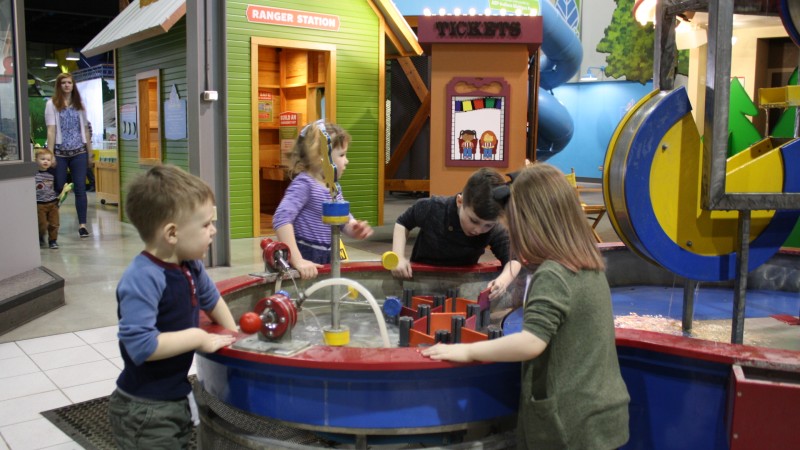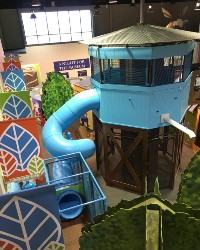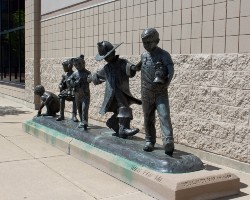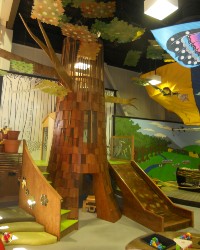Lifelong Educator Recalls Opening the First Hands-on Museum for Children in the Midwest


James M. Loy, Miami University
"Children's museums are not built in a day,” Liz Marshall ‘62, a lifelong educator, once wrote. “But just like children, they grow. They become stimulated by their environment. They become enriched and, finally, they make a meaningful contribution to their community."
So read Marshall’s prophetic quote, which was once used to energize community support around what, at the time, would be a novel way to awaken the natural curiosity and wonder of children.
That was over 40 years ago -- before Marshall would successfully help establish the Muncie Children’s Museum as one of the nation’s first hands-on learning centers to feature immersive and interactive activities for children of all ages.
At the time, many children’s museums featured static exhibits, Marshall recalls, with dead bugs pinned to foam boards, dusty collections of old rocks, or motionless stuffed animals adorned with signs that said, “Don’t touch.”
The kind of place Marshall had in mind would be different.
“I gave talks about what we were planning, and it was purely an idea that they were investing in, and it was a fairly peculiar idea,” she says. “It wasn't common. We were talking about a museum where the kids could explore, experiment, have an adventure, and touch absolutely everything.”
 A 21st century teacher in a 20th century society
A 21st century teacher in a 20th century society
However, before the Muncie Children’s Museum opened, very few existed, and only in far off metropolitan areas like New York City, Boston, Florida, and San Francisco. Nowhere near where Marshall spent her days as an elementary school teacher using her “hands-on” methods.
“At that time, there were no hands-on museums in the Midwest,” she says. “None.”
Yet envisioning the possibility of bringing one closer to home didn’t seem remote for Marshall, who had already become a forward-thinking advocate for hands-on and student-centered learning.
After graduating from Miami University in 1962 with a degree in elementary education, Marshall taught in Indianapolis, her home, and then in Arlington, Virginia, where her husband was stationed nearby as a Naval JAG Officer. Starting her MAEd at George Washington University in D.C., she completed her graduate work at Ball State University in Muncie, Indiana.
After her husband’s discharge, the couple moved to Muncie, where Marshall spent decades teaching elementary students from underprivileged homes. After her retirement, she also started a new career at Ivy Tech, where she enjoyed working with non-traditional adult students.
“Ever since my student teaching in Hamilton, [Ohio,] I've had this burning idea about how curriculum should work,” Marshall says. “I never really called myself a ‘teacher.’ In my mind, I was a facilitator. My philosophy was not teaching by lecturing, but in learning to learn. In that spirit, I wanted a creative curriculum that would be really appealing to kids.”
This philosophy included abiding by state and school standardizations when necessary. But it also meant following the lead of students, who were encouraged to help create their own curriculum by following their interests and imaginations as much as possible.
This student-centric approach is also more common now, but in an era of schooling primarily defined by neat rows of attentive students who were expected to memorize and regurgitate information, Marshall was already looking ahead to what education would become.
Instead of giving lectures on endangered animals, for example, she would accept invitations from the Indiana Division of Natural Resources so students could help conservation officers release wildlife into the Salamonie River. Experiential lessons around art, math, and reading were similarly woven into her curriculum, especially when the students themselves expressed an interest in a particular topic or local issue.
“If they felt that they had helped develop the curriculum, and were contributing to the curriculum, then they would learn,” she says. “And their scores just skyrocketed. They really did. Because they got to learn what they wanted to learn.”
So when the opportunity arose to incorporate similar educational experiences into an entire learning center, which could serve even more local children across the community, Marshall understood the value it could bring.
A legacy of hands-on learning
The genesis of the Muncie Children’s Museum began as early as 1975, before officially opening in 1977.
Marshall presided as Planning Executive for the original planning board before becoming the Founding President. The board initially drafted proposals, raised money, consulted with experienced museum directors and contractors, and decided that input from local children would inform every exhibit.
Exhibits were designed to be fun and immersive, while inspiring interest and curiosity. To this day, it’s a philosophy that still defines the museum’s mission, which is grounded in the genuine benefits of hands-on learning.
 Research shows that hands-on and experiential learning helps children make productive, meaningful, and lasting connections to the real world.
Research shows that hands-on and experiential learning helps children make productive, meaningful, and lasting connections to the real world.
It’s been linked to improved academic performance, as well as higher levels of problem solving, critical thinking, information retention, and even feelings of empowerment as students begin to see that education really does lead to observable accomplishments.
These are among the benefits that Marshall hopes modern exhibits like the Ant Wall, Water Works, the Nutrition Kitchen, and many more will continue to offer children, and their families, who now come from across the region to explore, experiment, and find adventure.
So, in an admirable postscript to her original quote drafted long ago, the Muncie Children’s Museum -- much like many of the children who have since passed through its doors -- has, in fact, grown into maturity as a thriving and enriching part of the community.
Today, the museum is still close to her heart, and she continues to attend, mostly on Saturdays, to visit with children, their parents, and even grandparents. It’s wonderful, she says, feeling that deep sense of connection that has endured for more than a generation.
“It's been viable now for over 40 years,” Marshall says. “It’s amazing. The kids become so involved. And I still sit on the advisory board to help oversee it. But anything takes a village. This has taken a metropolitan area. A lot of people have been involved over the years -- just wonderful people who realize how important it is for children to have their own space.”

